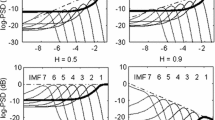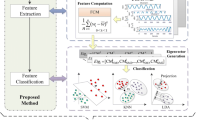Abstract
Purpose
Epileptic seizure is generated by abnormal synchronization of neurons of the cerebral cortex of the patients, which is commonly detected by electroencephalograph (EEG) signals. In this paper, the intracranial EEG signals have been used to detect focal temporal lobe epilepsy.
Methods
This paper presents a new method based on empirical mode decomposition (EMD) of EEG signals for detection of epileptic seizures. The proposed method uses the Hilbert transformation of intrinsic mode functions (IMFs), obtained by EMD process that provides analytic signal representation of IMFs. The instantaneous area measured from the trace of the windowed analytic IMFs of EEG signals provides rules-based detection of focal temporal lobe epilepsy.
Results
The experiment results on intracranial EEG signals are included to show the effectiveness of the proposed method for detection of focal temporal lobe epilepsy. The performance evaluation of the proposed method for epileptic seizure detection has performed by computing the sensitivity (SEN), specificity (SPE), positive predictive value (PPV), negative predictive value (NPV) and error rate detection (ERD).
Conclusions
The proposed method has been compared to the existing methods for detecting focal temporal lobe epilepsy from intracranial EEG signals. The proposed method has provided detection of focal temporal lobe epilepsy with increased accuracy.
Similar content being viewed by others
References
Mormann F, Andrzejak RG, Elger CE, Lehnertz K. Seizure prediction: the long and winding road. Brain. 2007; 130:314–333.
Li Z, Silva AM, Cunha JP. Movement quantification in epileptic seizures: a new approach to video-EEG analysis. IEEE T Bio-Med Eng. 2002; 49(6):565–573.
Casson A, Yates D, Smith S, Duncan J, Rodriguez-Villegas E. Wearable electroencephalography. What is it, why is it needed, and what does it entail? IEEE Eng Med Biol. 2010; 29(3):44–56.
Waterhouse E. New horizons in ambulatory electroencephalography. IEEE Eng Med Bio Mag. 2003; 22(3):74–80.
Cuppens K, Lagae L, Ceulemans B, Huffel SV, Vanrumste B. Detection of nocturnal frontal lobe seizures in pediatric patients by means of accelerometers: a first study. Conf Proc IEEE Eng Med Biol Soc. 2009; 6608–6611. DOI:10.1109/IEMBS.2009.5332557.
Cuppens K, Chen CW, Tuytelaars T, Vel AV, Lagae L, Huffel SV. Integrating video and accelerometer signals for nocturnal epileptic seizure detection. Proc Int Conf ACM Multimodal Interact. 2012; 161–164.
Tzallas AT, Tsipouras MG, Tsalikakis DG, Karvounis EC, Astrakas L, Konisiotis S, Tzaphlidou M. Automated epileptic seizure detection methods: a review study. Epilepsy — Histological, Electroencephalographic and Psychological Aspects. Dejan Stevanovic (Ed.). InTech. 2012.
Stacey WC, Litt B. Technology insight: neuroengineering and epilepsy-designing devices for seizure control. Nat Clin Pract Neurol. 2008; 4:190–201.
Ocak H. Optimal classification of epileptic seizures in EEG using wavelet analysis and genetic algorithm. Signal Process. 2008; 88:1858–1867.
Dastidar SG, Adeli H, Dadmehr N. Mixed-band wavelet-chaosneural network methodology for epilepsy and epileptic seizure detection. IEEE T Bio-Med Eng. 2007; 54(9):1545–1551.
Khan YU, Gotman J. Wavelet based automatic seizure detection in intracerebral electroencephalogram. Clin Neurophysiol. 2003; 114:898–908.
Kumar Y, Dewal ML, Anand RS. Epileptic seizures detection in EEG using DWT-based ApEn and artificial neural network. Signal Image Video Process. 2012; DOI:10.1007/s11760-012-0362-9
Guo L, Rivero D, Pazos A. Epileptic seizure detection using multiwavelet transform based approximate entropy and artificial neural networks. J Neurosci Meth. 2010; 193:156–163.
Tzallas AT, Tsipouras MG, Fotiadis DI. Automatic seizure detection based on time-frequency analysis and artificial neural networks. Comput Intell Neurosci. 2007. Article ID 80510, 2007.
Tzallas AT, Tsipouras MG, Fotiadis DI. Epileptic seizure detection in EEGs using time-frequency analysis. IEEE Trans Inf Technol Biomed. 2009; 13(5):703–710.
Güler NF, Übeyli ED, Güler İ. Recurrent neural networks employing Lyapunov exponents for EEG signals classification. Expert Syst Appl. 2005; 29(3):506–514.
Accardo A, Affinito M, Carrozzi M, Bouquet F. Use of the fractal dimension for the analysis of electroencephalographic time series. Biol Cybern. 1997; 77:339–350.
Lehnertz K, Elger CE. Spatio-temporal dynamics of the primary epileptogenic area in temporal lobe epilepsy characterized by neuronal complexity loss. Electroen Clin Neuro. 1995; 95(2):108–117.
Kannathal N, Choo ML, Acharya UR, Sadasivan PK. Entropies for detection of epilepsy in EEG. Comput Meth Progr Bio. 2005; 80:187–194.
Huang NE, Shen Z, Long SR, Wu MC, Shih HH, Zheng Q, Yen NC, Tung CC, Liu HH. The empirical mode decomposition and Hilbert spectrum for nonlinear and non-stationary time series analysis. Proc R Soc Lond A. 1988; 454:903–995.
Pachori RB. Discrimination between ictal and seizure-free EEG signals using empirical mode decomposition. Res Lett Signal Process. 2008; Article ID 293056.
Pachori RB, Bajaj V. Analysis of normal and epileptic seizure EEG signals using empirical mode decomposition. Comput Meth Progr Bio. 2011; 104(3):373–381.
Bajaj V, Pachori RB. Classification of seizure and nonseizure EEG Signals using empirical mode decomposition. IEEE Trans Inf Technol Biomed. 2012; 16(6):1135–1142.
Orosco L, Laciar E, Correa AG, Torres A, Graffigna JP. An epileptic seizures detection algorithm based on the empirical mode decomposition of EEG. Conf Proc IEEE Eng Med Biol Soc. 2009; 2651–2654. DOI:10.1109/IEMBS.2009.5332861.
Correa AG, Laciar E, Orosco L, Gomez ME, Otoya R, Jane R. An energy-based detection algorithm of epileptic seizure in EEG records. Conf Proc IEEE Eng Med Biol Soc. 2009; 1384-7. DOI:10.1109/IEMBS.2009.5334114.
Freiburg EEG Database Available: http://epilepsyuni-freiburg.de/freiburg-seizure-prediction-project/eeg-database.
Maiwald T, Winterhalder M, Aschenbrenner-Scheibe R, Voss HU, Schulze-Bonhage A, Timmer J. Comparison of three nonlinear seizure prediction mathods by means of the seizure prediction characteristic. Physica D. 2004; 194:357–368.
Lai YC, Ye N. Recent developments in chaotic time series analysis. Int J Bifurcat Chaos. 2003; 13(6):1383–1422.
Amoud H, Snoussi H, Hewson DJ, Duchêne J. Hilbert-Huang transformation: Application to postural stability analysis. Conf Proc IEEE Eng Med Biol Soc. 2007; 1562-5.
Altman DG. Some common problems in medical research, in practical statistics for medical research. Chapman and Hall, UK. 1993; 396–439.
Ahirwal MK, Kumar A, Singh GK. Analysis and testing of PSO variants through application in EEG/ERP adaptive filtering approach. Biomed Eng Lett. 2012; 2(3):186–197.
Author information
Authors and Affiliations
Corresponding author
Rights and permissions
About this article
Cite this article
Bajaj, V., Pachori, R.B. Epileptic seizure detection based on the instantaneous area of analytic intrinsic mode functions of EEG signals. Biomed. Eng. Lett. 3, 17–21 (2013). https://doi.org/10.1007/s13534-013-0084-0
Received:
Revised:
Accepted:
Published:
Issue Date:
DOI: https://doi.org/10.1007/s13534-013-0084-0




